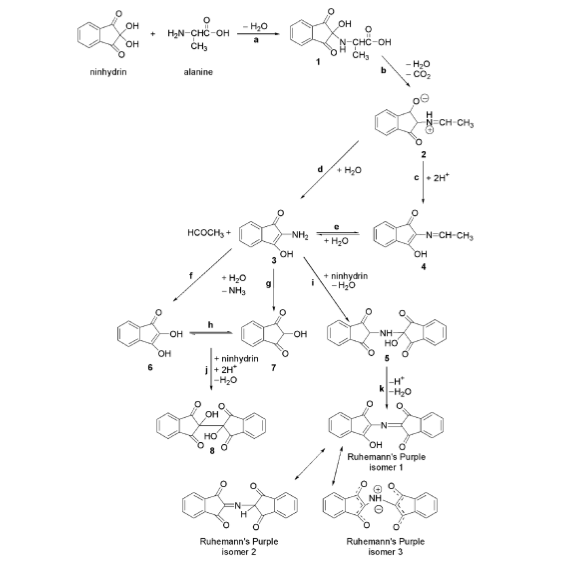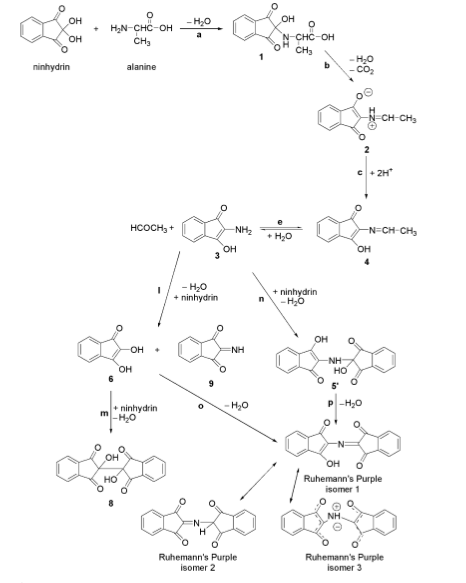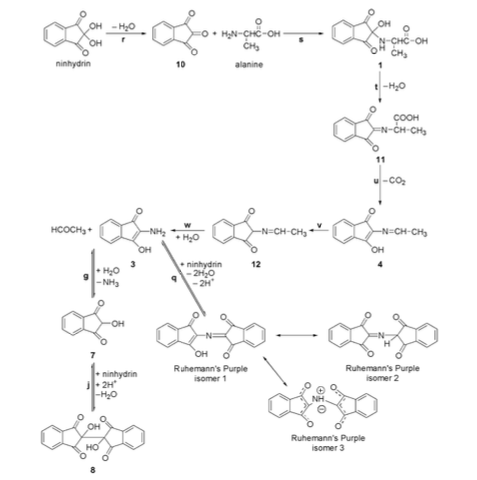Difference between revisions of "Ninhydrin Reaction with Alanine in Latent Fingerprints"
| (3 intermediate revisions by the same user not shown) | |||
| Line 9: | Line 9: | ||
===Calculations=== | ===Calculations=== | ||
| − | The molecular energy calculations were ran with WebMo/Gaussian using the Hartree-Fock theory and 6-31G basis set. | + | The molecular energy calculations were ran with WebMo/Gaussian using the Hartree-Fock theory and 6-31G basis set. The numbers in the chart can be found by looking at the above figures, the numbers correspond with specific compounds. The ΔE of reaction a was also calculated by using the Products - Reactants formula. |
| + | |||
{| class="wikitable" | {| class="wikitable" | ||
|- | |- | ||
| Line 59: | Line 60: | ||
|- | |- | ||
|} | |} | ||
| + | |||
| + | '''ΔE Calculations''' | ||
| + | |||
| + | The multiple reactions are denoted by letters a through w. The ΔE calculation was done by converting the energy values from the chart to kcal/mol. The conversion factor is 627.51 kcal/mol = 1 Hartree. I took Products - Reactants to get my ΔE. | ||
| + | |||
| + | The reaction: | ||
| + | Ninhydrin+alanine --> 1 +H<sub>2</sub>O | ||
| + | |||
| + | (-889.50 Hartree + -75.98 Hartree) - (-643.27 Hartree + -321.77 Hartree) = -0.44 Hartree | ||
| + | |||
| + | -.044 Hartree * 627.51 kcal/mol = 276.1 kcal/mol | ||
| + | |||
| + | *My ΔE value was different than the original paper's value was. They got the value of 7.08 kcal/mol. | ||
===Conclusion=== | ===Conclusion=== | ||
| + | It can be concluded that under high temperatures, where extra energy is available, this reaction is energetically feasible. All three different mechanisms work best under high temperature conditions. The multiple reaction paths lead to higher yields of Ruhemann's purple. Higher yields of Ruhemann's purple creates more of a chromophore when it reacts with the amino acid. | ||
| + | |||
===Citations=== | ===Citations=== | ||
Latest revision as of 21:55, 15 April 2021
This is an ab initio computational chemistry project and all energies of the compounds in this multi-step reaction were calculated via WebMo, using the Hartree-Fock theory and 6-31G basis set to calculate molecular energy.
Background
Fingerprinting is an important tool used in forensic science and solving crimes. Latent fingerprints is one of the easiest ways to connect an individual with the crime. These types of fingerprints are created when any surface is touched and there is a transfer of a thin layer of chemical residue from the tips of your fingers. Multiple methods of lifting fingerprints are used, but chemical methods is the most effective for nonporous surfaces.[1] In this project, I am focusing on the use of a ninhydrin spray to lift a fingerprint. Ninhydrin reacts with the proteins in the latent fingerprint and create an amino acid residue that becomes a purple color after a multi-step reaction. The ninhydrin condenses the primary amine of an amino acid, alanine in this case, to form an imine. The resulting imine decarboxylates and hydrolyzes in water to form another primary amine that condenses with a second ninhydrin molecule to form Ruhemann's purple.[2]
Calculations
The molecular energy calculations were ran with WebMo/Gaussian using the Hartree-Fock theory and 6-31G basis set. The numbers in the chart can be found by looking at the above figures, the numbers correspond with specific compounds. The ΔE of reaction a was also calculated by using the Products - Reactants formula.
| Structure | Energy (Hartree) | Run Time |
|---|---|---|
| Ninhydrin | -643.27 | 7.3 sec |
| Alanine | -321.77 | 2.1 sec |
| 1 | -889.50 | 27.6 sec |
| 2 | -626.84 | 21.3 sec |
| 3 | -548.97 | 10.6 sec |
| Acetaldehyde | -152.91 | 0.6 sec |
| 4 | -625.77 | 16.7 sec |
| 5 | -1041.85 | 43.0 sec |
| 5' | -1117.79 | 50.4 sec |
| 6 | -568.77 | 9.7 sec |
| 7 | -568.84 | 9.9 sec |
| 8 | -1128.16 | 7 min 11 sec |
| 9 | 547.69 | 9.7 sec |
| 10 | -567.65 | 4.9 sec |
| 11 | -813.39 | 24.3 sec |
| 12 | -625.82 | 14.1 sec |
| Ruhemann's purple, isomer 1 | -1040.48 | 1 min 15 sec |
| Ruhemann's purple, isomer 2 | -1040.57 | 1 min 1 sec |
| Ruhemann's purple, isomer 3 | -1041.07 | 2 min 43 sec |
| Water | -75.98 | 0.6 sec |
| Carbon Dioxide | -185.58 | 0.6 sec |
| Ammonia | -56.10 | 0.6 sec |
ΔE Calculations
The multiple reactions are denoted by letters a through w. The ΔE calculation was done by converting the energy values from the chart to kcal/mol. The conversion factor is 627.51 kcal/mol = 1 Hartree. I took Products - Reactants to get my ΔE.
The reaction: Ninhydrin+alanine --> 1 +H2O
(-889.50 Hartree + -75.98 Hartree) - (-643.27 Hartree + -321.77 Hartree) = -0.44 Hartree
-.044 Hartree * 627.51 kcal/mol = 276.1 kcal/mol
- My ΔE value was different than the original paper's value was. They got the value of 7.08 kcal/mol.
Conclusion
It can be concluded that under high temperatures, where extra energy is available, this reaction is energetically feasible. All three different mechanisms work best under high temperature conditions. The multiple reaction paths lead to higher yields of Ruhemann's purple. Higher yields of Ruhemann's purple creates more of a chromophore when it reacts with the amino acid.




